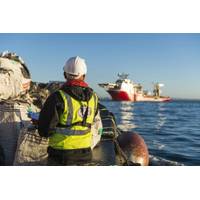Hurricane Energy Buoyed by Post-well Analysis Results
Hurricane Energy plc, the UK-based oil and gas company, announced having substantially completed post-well data analysis following the successful testing of the 1km horizontal appraisal well 205/21a-6 in Q2 2014 at the Company's Lancaster oil discovery West of Shetland.
The well was optimally located to benefit from a highly connected fault/fracture network and an underlying 300m oil column (Hurricane's - 2C estimate of field ODT). The results from third party analysis combine to demonstrate a very good quality reservoir which could deliver single well rates of 20,000 STB/d - significantly ahead of initial expectations of well productivity.
Summary information:
The well test achieved a sustainable natural flow rate of 5,300 STB/d and a flow rate using artificial lift (using an electrical submersible pump) of 9,800 STB/d. Both rates were constrained by surface equipment.
* Well flowed for a total of 78 hours and shut in for a maximum of 22 hours.
* Shut in pressures indicate a rapid pressure response and no observable pressure decline.
* Data from this well indicates that under production conditions and a moderate 120 psi drawdown the basement reservoir could deliver 20,000 STB/d from a single well.
* PVT and geochemical analysis reconfirm the wellsite analysis that the oil is 38 degrees API and consistent with that produced from previous Lancaster wells.
* Well productivity index of 160/STB/d/psi demonstrates a very good quality reservoir pressure capable of delivering
sustained commercial flow under production conditions.
* Tidal data and modelled well test pressure response indicate that the intervening fractured basement rock, as well as the seismic scale fault zones, contributed to flow. The tidal data is extremely important as it not only corroborates the pre-drill geological model but provides new analysis that demonstrates a highly permeable, well connected fracture network.
* Pressure response indicates that the drilling programme was successful at minimising skin damage to the near wellbore environment.
* No evidence of barriers within the fractured basement reservoir in the duration of this test.
* Target faults identified from pre-drill seismic analysis were encountered as expected, providing the company with a high degree of confidence for future well placement.
* Additional upside was encountered from an interval of previously undrilled Jurassic-Cretaceous sandstone. The sandstone is oil bearing, and has an average porosity of 16%; however further subsurface work is required to quantify the materiality of this reservoir sandstone.
* Graphical representations of the well test data including Full Test History Match and Final Pressure Build-Up
Dr Robert Trice, Chief Executive, commented, "I am delighted to report that our work on the well data gathered during the recent testing of Lancaster confirms our pre-drill geological model of the fractured basement, as well as significantly advancing our understanding of how the fracture network behaves. Importantly, the key metrics related to oil productivity are even better than expected providing us with further encouragement regarding the productive potential of Lancaster and our other basement assets.
"Such a level of productivity means that an early phase of field development and commercial production could be initiated with the addition of only one more horizontal well. As previously reported, we have a data room open for potential farm-inees, however the benefit of having two suspended proven producers and holding 100 per cent. of our acreage means that we have a broad range of options to progress the Lancaster Field development and our other assets."
www.hurricaneenergy.com.











